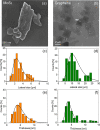Sustainable Liquid-Phase Exfoliation of Layered Materials with Nontoxic Polarclean Solvent
- PMID: 33828931
- PMCID: PMC8018326
- DOI: 10.1021/acssuschemeng.0c04191
Sustainable Liquid-Phase Exfoliation of Layered Materials with Nontoxic Polarclean Solvent
Abstract
Liquid-phase exfoliation is the most suitable platform for large-scale production of two-dimensional materials. One of the main open challenges is related to the quest of green and bioderived solvents to replace state-of-the-art dispersion media, which suffer several toxicity issues. Here, we demonstrate the suitability of methyl-5-(dimethylamino)-2-methyl-5-oxopentanoate (Rhodiasolv Polarclean) for sonication-assisted liquid-phase exfoliation of layered materials for the case-study examples of WS2, MoS2, and graphene. We performed a direct comparison, in the same processing conditions, with liquid-phase exfoliation using N-methyl-2-pyrrolidone (NMP) solvent. The amount of few-layer flakes (with thickness <5 nm) obtained with Polarclean is increased by ∼350% with respect to the case of liquid-phase exfoliation using NMP, maintaining comparable values of the average lateral size, which even reaches ∼10 μm for the case of graphene produced by exfoliation in Polarclean, and of the yield (∼40%). Correspondingly, the density of defects is reduced by 1 order of magnitude by Polarclean-assisted exfoliation, as evidenced by the I(D)/I(G) ratio in Raman spectra of graphene as low as 0.07 ± 0.01. Considering the various advantages of Polarclean over state-of-the-art solvents, including the absence of toxicity and its biodegradability, the validation of superior performances of Polarclean in liquid-phase exfoliation paves the way for sustainable large-scale production of nanosheets of layered materials and for extending their use in application fields to date inhibited by toxicity of solvents (e.g., agri-food industry and desalination), with a subsequent superb impact on the commercial potential of their technological applications.
© 2020 American Chemical Society.
Conflict of interest statement
The authors declare no competing financial interest.
Figures







References
-
- Jia L.; Zhang J.; Su G.; Zheng Z.; Zhou T. Locally Controllable Surface Foaming of Polymers Induced by Graphene Via near-Infrared Pulsed Laser. ACS Sustainable Chem. Eng. 2020, 8, 2498–2511. 10.1021/acssuschemeng.9b07046. - DOI
-
- Liu M.; Sun K.; Zhang Q.; Tang T.; Huang L.; Li X.; Zeng X.; Hu J.; Liao S. Rationally Designed Three-Dimensional N-Doped Graphene Architecture Mounted with Ru Nanoclusters as a High-Performance Air Cathode for Lithium-Oxygen Batteries. ACS Sustainable Chem. Eng. 2020, 8, 6109–6117. 10.1021/acssuschemeng.0c01237. - DOI
-
- Liu Y.; Sun K.; Cui X.; Li B.; Jiang J. Defect-Rich, Graphenelike Carbon Sheets Derived from Biomass as Efficient Electrocatalysts for Rechargeable Zinc-Air Batteries. ACS Sustainable Chem. Eng. 2020, 8, 2981–2989. 10.1021/acssuschemeng.9b07621. - DOI
-
- Liu Y.; Wang W.; Zhang S.; Li W.; Wang G.; Zhang Y.; Han M.; Zhang H. Mos2 Nanodots Anchored on Reduced Graphene Oxide for Efficient N2 Fixation to NH3. ACS Sustainable Chem. Eng. 2020, 8, 2320–2326. 10.1021/acssuschemeng.9b07679. - DOI
-
- Wen X.; Zhao M.; Zhang M.; Fan X.; Zhang D. Efficient Capacitive Deionization of Saline Water by an Integrated Tin Disulfide Nanosheet@Graphite Paper Electrode Via an in Situ Growth Strategy. ACS Sustainable Chem. Eng. 2020, 8, 1268–1275. 10.1021/acssuschemeng.9b06535. - DOI
LinkOut - more resources
Full Text Sources
